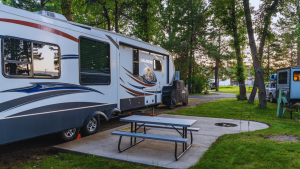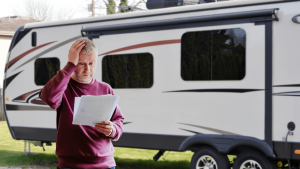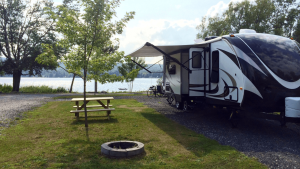Camper FAQs is reader-supported. Buying through links on our site may earn us an affiliate commission. As an Amazon Associate I earn from qualifying purchases.
Before you buy that next RV accessory or upgrade, it might be worth taking a closer look.
I’ve personally seen the same mistakes repeated again and again: money spent on gear that ends up in the trash, causes unexpected damage, or just never gets used.
And I’m not going to lie, I’ve bought a few of these items myself. So I felt it appropriate to help others avoid these common purchases that are, at best, a waste of money.
Each of these comes from real-world feedback from RV owners, technicians, and full-timers who’ve learned what actually works and what falls short.
1. Aftermarket Pin Boxes
Swapping out the stock pin box on a fifth wheel might seem like a good upgrade, especially for those looking for a smoother towing experience or wanting to switch hitch styles. However, many aftermarket pin boxes are not approved by the RV’s chassis manufacturer. Using an unapproved unit can alter the stress distribution across the frame, potentially causing frame flex, sidewall cracks, or long-term structural damage. These modifications can also lead to warranty issues and denied insurance claims.
Better alternative: Contact your RV manufacturer with your VIN to find out which pin boxes are approved for your chassis before making any changes.
2. RV-Specific Toilet Paper
Toilet paper marketed as “RV-safe” is often overpriced and unnecessarily rough. Many of these products claim to break down faster in black tanks, but user tests show that a wide variety of septic-safe household toilet papers break down just as effectively. The key factor is how much water is used during flushing and how well tanks are maintained, not whether the label says “RV.”
Better alternative: Use a septic-safe residential toilet paper brand that performs well in breakdown tests and is comfortable for regular use.
3. Ladder-Mounted Cargo Racks
Attaching cargo like chairs, totes, or bike racks to an RV’s rear ladder can cause multiple issues. Ladders are not designed to carry loads while the RV is moving, especially not over long distances or bumpy roads. The added weight and bouncing stress can loosen ladder mounts, cause leaks around mounting points, and even lead to the ladder potentially breaking when you’re using it.
Better alternative: Use frame-mounted or hitch-mounted cargo carriers specifically rated for your RV’s design and towing limits.
4. RV Wi-Fi Gateways
Many RVs come prepped for or equipped with Wi-Fi extenders or mobile internet gateways. These systems often require a separate module and subscription, but the performance is typically underwhelming. They rarely offer better speeds or coverage than a smartphone hotspot and often have limited configuration options. Additionally, some use outdated technology that doesn’t support newer cellular networks.
Better alternative: Use a dedicated mobile hotspot device or satellite internet system like Starlink, which tends to provide stronger and more consistent connectivity.
5. Campground Memberships
Campground membership programs promise discounted or exclusive access to affiliated parks, but they often require upfront fees and annual dues. Many RVers find that they don’t camp often enough or at the right locations to break even on the cost. Some memberships also limit flexibility, as users may feel obligated to use the network they’ve paid into, even if better options are available elsewhere.
Better alternative: I’m actually a fan of memberships if you can make them work for you. Spend your first year RVing without a membership to understand your camping habits. And then thoroughly research RV memberships you are interested in to make sure they will be a good fit and worth the money.
6. Small Green Propane Bottles
The 1-pound disposable propane cylinders commonly used for grills and cooktops are convenient but not cost-effective over time. They are also wasteful and many people throw them in the trash, which is not the recommended method for pressurized containers. These bottles also tend to run out quickly, requiring frequent replacements during longer trips.
Better alternative: I suppose these disposable bottles have their place, but in most cases, you are better off using refillable propane tanks connected to your appliances with an adapter hose. This reduces waste and cuts costs after just a few uses.
7. Improper RV Insurance
Many RV owners are unknowingly underinsured. Insurance policies are sometimes arranged quickly at the point of sale and may not account for how the RV is actually used, such as for full-time living or additional accessories. If a claim is filed and the policy doesn’t match the usage, coverage may be denied. This issue affects a large number of RVers and often isn’t discovered until it’s too late.
Better alternative: Speak directly with an insurance agent, preferably one who knows the ins and outs of specialized RV insurance. Explain how you use your RV and request a policy review to confirm that your coverage is accurate.
8. Cheap Wheel Chocks
Plastic or lightweight wheel chocks often crack, shift, or degrade rather quickly. They may appear secure when first placed, but can loosen during setup or fail to hold a trailer in place under stress. This is particularly risky on sloped campsites or with heavier rigs. Cheap chocks (say that 5 times fast) also tend to weather poorly and break down faster with UV exposure.
Better alternative: Use heavy-duty rubber wheel chocks or X-chocks made for tandem axle trailers. These offer better grip, durability, and overall stability.
9. Breakable Dishware
Standard ceramic or glass dishware isn’t built for the constant motion and vibrations of RV travel. These items are prone to breaking, chipping, or making noise while driving. During travel days, they can also pose a hazard if cabinets are not packed securely. Many RVers end up replacing these items after the first trip.
Better alternative: Use melamine, stainless steel, or tin dishware. These materials are lightweight, quieter, and much more durable for mobile living.
10. Slide-Out Support Jacks
Slide support jacks are designed to brace slide-outs from underneath while extended. However, most modern RV slide systems are engineered to support their own weight without external support. Using these jacks can interfere with how the slide and RV frame move together, potentially causing misalignment, seal gaps, or mechanical stress. Some systems can even be damaged if improperly braced.
Better alternative: Do not use slide supports unless your RV manufacturer specifically requires them. For nearly all newer RVs, they are unnecessary and can do more harm than good.
11. Cheap Sewer Hoses
Cheap sewer hoses tend to kink or crack fairly quickly. Trust me, this isn’t something you want to give out! When pressure is applied, such as during tank dumping, thin, cheap hoses are more likely to fail, creating… unsanitary situations, to put it mildly. These problems are especially common in cold weather or when stretched across long distances.
Better alternative: Invest in a heavy-duty sewer hose from a reputable brand, like the Camco RhinoFlex, for example. Brands that maintain shape and flexibility are worth the extra cost for both convenience and hygiene.
12. Low-Quality Tank Treatments
Some inexpensive holding tank treatments do little to control odor or waste breakdown. Many contain chemicals like formaldehyde, which may harm septic systems and are restricted in some campgrounds. Poor treatment can lead to foul smells in both black and gray tanks, as well as buildup in sensors, causing inaccurate readings (if you even rely on sensors).
Better alternative: Use an enzyme- or bacteria-based treatment designed to break down waste and control odor naturally. Look for products labeled safe for all septic systems and free from harsh chemicals.
13. Cheap RV Sealants
Budget sealants used on roofs, windows, or seams can fail prematurely, especially when exposed to sun, rain, and other harsh elements. These products may crack, peel, or lose adhesion, leading to leaks and water damage. Once compromised, they can be difficult to remove and reapply correctly, costing more in repairs than the original savings.
Better alternative: Use RV-specific sealants from trusted brands like Dicor or Sikaflex. These products are made to handle movement, temperature changes, and UV exposure commonly encountered during RV use.
To wrap it up, there’s no shortage of gadgets, gear, and “must-haves” pitched to RVers. Some work well, others just take up space or cause more trouble than they’re worth. Everyone’s experience is different, though, and that’s where you come in.
What have you bought for your RV that turned out to be a waste of money? Let us know in the comments. Your story might help someone else avoid the same mistake.







Write a comment